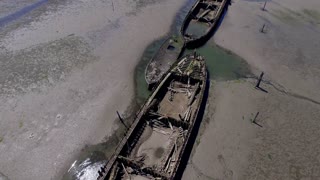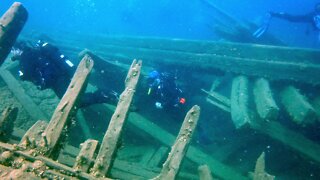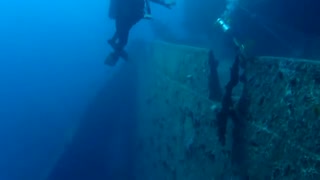Wooden Ships, Iron Men (Hell Divers 1931)
Clark Gable & Wallace Beery.
THERE ARE TWO U.S. NAVY SHIPS THAT HOLD THE DISTINCTION OF BEING THE FIRST AIRCRAFT CARRIERS.
FIRST WAS THE USS Langley (CV-1/AV-3) which was the United States Navy's first surface aircraft carrier.
Converted in 1920 from the collier USS Jupiter (AC-3), and also the US Navy's first turbo-electric-powered ship. Conversion of another collier was planned but canceled when the Washington Naval Treaty required the cancellation of the partially built Lexington-class battle cruisers Lexington and Saratoga, freeing up their hulls for conversion to the aircraft carriers Lexington and Saratoga.
FIRST FORGOTTEN UNITED STATES AIRCRAFT CARRIER.
USS Los Angeles was the United States Navy's first Airborne Airship aircraft carrier.
A rigid airship, designated ZR-3, which was built in 1923–1924 by the Zeppelin company in Friedrichshafen, Germany, as war reparation. The USS Los Angeles, was built for the United States Navy as a replacement for the Zeppelins that had been assigned to the United States as war reparations following World War I, and had been sabotaged by their crews in 1919.
It was delivered to the United States Navy in October 1924 and after being used mainly for experimental work, particularly in the development of the American parasite fighter program, was decommissioned in 1932.
Los Angeles was first flown on 27 August 1924, and after completing flight trials began the transatlantic delivery flight on 12 October under the command of Hugo Eckener, arriving at the US Naval Air Station at Lakehurst, New Jersey, after an 81-hour flight of 4,229 nautical miles (7,832 km; 4,867 mi). The airship was commissioned into the US Navy on 25 November 1924 at Anacostia, D.C. with Lieutenant Commander Maurice R. Pierce in command.
On its arrival in the United States, its lifting gas was changed from hydrogen to helium, which reduced payload but improved safety.
At the same time the airship was fitted with equipment to recover water from the exhaust gases for use as ballast to compensate for the loss of weight as fuel was consumed, so avoiding the necessity to vent scarce helium to maintain neutral buoyancy.
The airship went on to log a total of 4,398 hours of flight, covering a distance of 172,400 nautical miles (319,300 km; 198,400 mi). Long-distance flights included return flights to Panama, Costa Rica and Bermuda. It served as an observatory and experimental platform, as well as a training ship for other airships.
FIRST AIRBORNE AIRCRAFT CARRIER.
In 1929, Los Angeles was used to test the trapeze system developed by the US Navy to launch and recover fixed wing aircraft from rigid airships. The tests were a success and the later purpose-built Akron-class airships were fitted with this system. The temporary system was removed from Los Angeles, which never carried any aircraft on operational flights. On 31 January 1930, Los Angeles also tested the launching of a glider over Lakehurst, New Jersey.
On 25 May 1932, Los Angeles participated in a demonstration of photophone technology. Floating over the General Electric plant in Schenectady, New York, the crew of the ship engaged in an on-air conversation with a WGY radio announcer using a beam of light.
As the terms under which the Allies permitted the United States to have Los Angeles restricted its use to commercial and experimental purposes only, when the U.S. Navy wanted to use the airship in a fleet problem in 1931 permission had to be obtained from the Allied Control Commission.[9] Los Angeles took part in Fleet Problems XII (1931) and XIII (1932), although as was the case with all U.S. Navy rigid airships, demonstrated no particular benefit to the fleet.
Los Angeles was decommissioned in 1932 as an economy measure, but was recommissioned after the crash of USS Akron in April 1933. She flew for a few more years and then retired to her Lakehurst hangar where she remained until 1939, when the airship was struck off the Navy list and was dismantled in her hangar.
Los Angeles was the Navy's longest serving rigid airship. Unlike Shenandoah, Akron, and Macon, the German-built Los Angeles was the only Navy rigid airship which did not meet a disastrous end.
-
 11:07
11:07
Ray4395
9 months agoWooden Ships and Iron Men game
11 -
 3:02
3:02
Rigel2112
3 years ago4k Wooden Shipwrecks
31 -
 1:54
1:54
JimmysMooies
3 years agoWooden Boat Plans
81 -
 2:01
2:01
WildCreatures
1 year ago $0.09 earnedDivers explore eerie wreck of a ship lost more than a century ago
3.14K5 -
 1:27
1:27
NewHampshire603
2 years agoLoons or Divers
53 -
 5:15
5:15
CruiseROWaterMakers
1 year agoMarine Water Makers and a Dedicated Through Hull
3 -
 3:04
3:04
Safety At Sea
3 years ago $0.01 earnedMan Overboard! THIS IS NOT A DRILL
33 -
 0:17
0:17
SamuelKoi
5 years agoDivers Explore Lost Ship Under The Sea
2 -
 5:01:42
5:01:42
Seas Knots Military Game Stream
1 year ago $0.05 earnedShips and Hammers
379 -
 3:34
3:34
OnlyT Music Place
2 years agoBarry Manilow - Ships
167